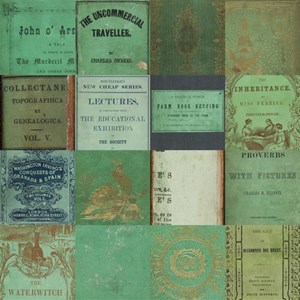New Tool to identify ‘Toxic’ Green Books

A groundbreaking tool developed by the University of St Andrews is transforming how cultural heritage institutions identify toxic pigments in historic books, making it easier than ever to distinguish hazardous books from those which are safe handle and display.
The new device, developed in collaboration between The University of St Andrews Libraries and Museums and the School of Physics and Astronomy, can quickly and cheaply detect the presence of toxic pigment in book bindings.

Although it has long been known that historic wall papers and textiles, particularly those coloured a vivid green may contain arsenic, the focus in recent years has been on bright green coloured book bindings. This is because publishers used arsenic to achieve a vibrant green colour known as emerald green. While the risk to the public is low, frequent handling of these books can lead to health issues like irritation of the eyes, nose, and throat, and potentially more serious effects, causing concern for those who handle books on a regular basis.

Recently, libraries and collections from around the world, including the French National Library in 2024, have had to prevent access to parts of their book collections. Whilst testing is available it has, until now, been a specialised, costly, and time-consuming process, leading many institutions to simply prevent access to all suspect green books from their collections as a precaution. Last year the The University of Bielefeld, along with several other German universities, isolated around 60,000 books as a precautionary measure.
Dr Pilar Gil, Heritage Scientist from University Collections who lead the research, said, “The project began with the need to positively identify emerald green bindings in the University of St Andrews collections, using the analytical techniques available to us within the University. A device used in the School of Earth Sciences to detect minerals in rocks was the starting point, and the Eureka moment was discovering the unique reflectance pattern from emerald green pigment in the visible spectrum. The idea was then to apply this discovery to an instrument which we could use and share with the sector.”
Dr Graham Bruce and Dr Morgan Facchin from the School of Physics and Astronomy developed a portable tool to identify the poisonous books. Dr Facchin said: “Our device shines different colours of light onto the book. The amount of light reflected at each colour is like a fingerprint of the pigment in the book. Through extensive work using books from the University’s collections, our team have found a way to identify the fingerprint of emerald green on a book.”

Dr Bruce added: “The device that we have developed is handheld and allows us to screen an individual book for the presence of emerald green pigment in a fraction of a second. It has been exciting to see it being used in libraries and collections across Scotland. Our team has been asked to look at thousands of books, of which over 100 have been identified as containing emerald green pigment.”
Accredited conservator, Erica Kotze from the University of St Andrews who instigated the programme said, “The retention of green books from public view is not only a matter of safety, but it also restricts access to the information contained. This means that the books which have been tested and found not to contain the pigment can remain available to users. This project has been an interesting collaboration and has been well-received by colleagues in the sector who will be able to more accurately target collections which need special handling.”
Assistant Director in Libraries and Museums, Dr Jessica Burdge said, “This work is a brilliant example of how universities and research can solve real problems. The emerald green detection tool is the result of a collaboration that plays to the strengths of different expertise across the University and takes advantage of our fortunate position to have access to expensive analytical equipment, to create something simple easy and cheap for others to use.”
It is hoped that this tool will enable public and private institutions both large and small to accurately identify poisonous books in their collections.
